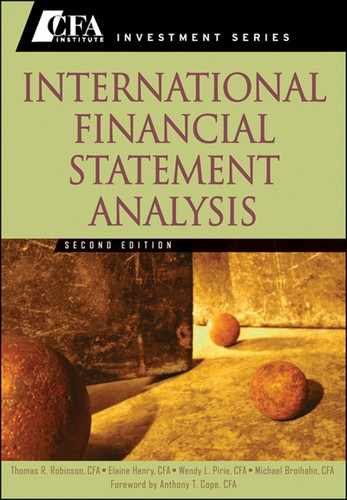CONTENTS
About the CFA Institute Investment Series
Chapter 1: Financial Statement Analysis: An Introduction
2. Scope of Financial Statement Analysis
3. Major Financial Statements and Other Information Sources
4. Financial Statement Analysis Framework
Chapter 2: Financial Reporting Mechanics
2. The Classification of Business Activities
3. Accounts and Financial Statements
5. Accruals and Valuation Adjustments
7. Using Financial Statements in Security Analysis
Appendix 2A: A Debit/Credit Accounting System
Chapter 3: Financial Reporting Standards
2. The Objective of Financial Reporting
3. Standard-Setting Bodies and Regulatory Authorities
4. Convergence of Global Financial Reporting Standards
5. The International Financial Reporting Standards Framework
6. Effective Financial Reporting
7. Comparison of IFRS with Alternative Reporting Systems
8. Monitoring Developments in Financial Reporting Standards
Chapter 4: Understanding Income Statements
2. Components and Format of the Income Statement
5. Nonrecurring Items and Nonoperating Items
7. Analysis of the Income Statement
Chapter 5: Understanding Balance Sheets
2. Components and Format of the Balance Sheet
3. Current Assets and Current Liabilities
7. Analysis of the Balance Sheet
Chapter 6: Understanding Cash Flow Statements
2. Components and Format of the Cash Flow Statement
3. The Cash Flow Statement: Linkages and Preparation
4. Cash Flow Statement Analysis
Chapter 7: Financial Analysis Techniques
2. The Financial Analysis Process
3. Analytical Tools and Techniques
4. Common Ratios Used in Financial Analysis
7. Business and Geographic Segments
8. Model Building and Forecasting
Chapter 8: Financial Statement Analysis: Applications
2. Application: Evaluating Past Financial Performance
3. Application: Projecting Future Financial Performance
4. Application: Assessing Credit Risk
5. Application: Screening for Potential Equity Investments
6. Analyst Adjustments to Reported Financials
3. Inventory Valuation Methods
7. Evaluation of Inventory Management
2. Acquisition of Long-Lived Assets
3. Depreciation and Amortization of Long-Lived Assets
7. Presentation and Disclosures
2. Differences Between Accounting Profit and Taxable Income
3. Determining the Tax Base of Assets and Liabilities
4. Temporary and Permanent Differences Between Taxable and Accounting Profit
5. Unused Tax Losses and Tax Credits
6. Recognition and Measurement of Current and Deferred Tax
7. Presentation and Disclosure
8. Comparison of IFRS and U.S. GAAP
Chapter 12: Noncurrent (Long-Term) Liabilities
4. Introduction to Pensions and Other Postemployment Benefits
5. Evaluating Solvency: Leverage and Coverage Ratios
Chapter 13: Employee Compensation: Postemployment and Share-Based
2. Pensions and Other Postemployment Benefits
Chapter 14: Intercorporate Investments
2. Basic Corporate Investment Categories
3. Investments in Financial Assets
7. Variable Interest and Special Purpose Entities
Chapter 15: Multinational Operations
2. Foreign Currency Transactions
3. Translation of Foreign Currency Financial Statements
Chapter 16: Evaluating Financial Reporting Quality
2. Discretion in Accounting Systems
3. Financial Reporting Quality: Definitions, Issues, and Aggregate Measures
4. A Framework for Identifying Low-Quality Financial Reporting
5. The Implications of Fair Value Reporting for Financial Reporting Quality: A Brief Discussion
Chapter 17: Integration of Financial Statement Analysis Techniques
2. Case Study 1: Long-Term Equity Investment
3. Case Study 2: Off-Balance Sheet Leverage From Operating Leases
4. Case Study 3: Anticipating Effects of Changes in Accounting Standards
